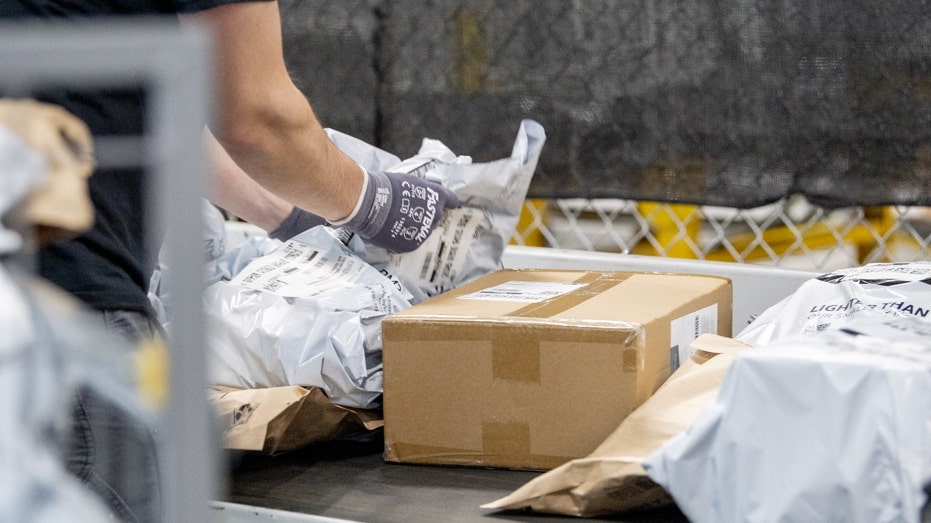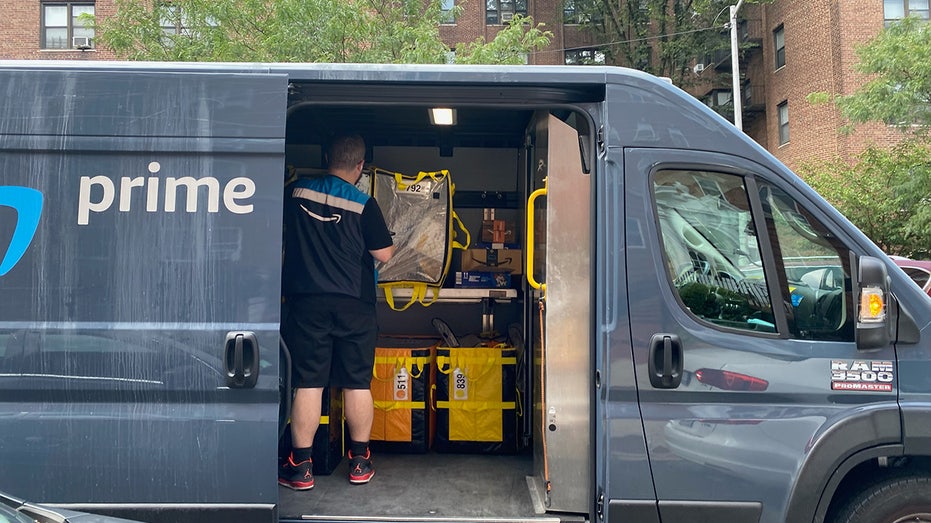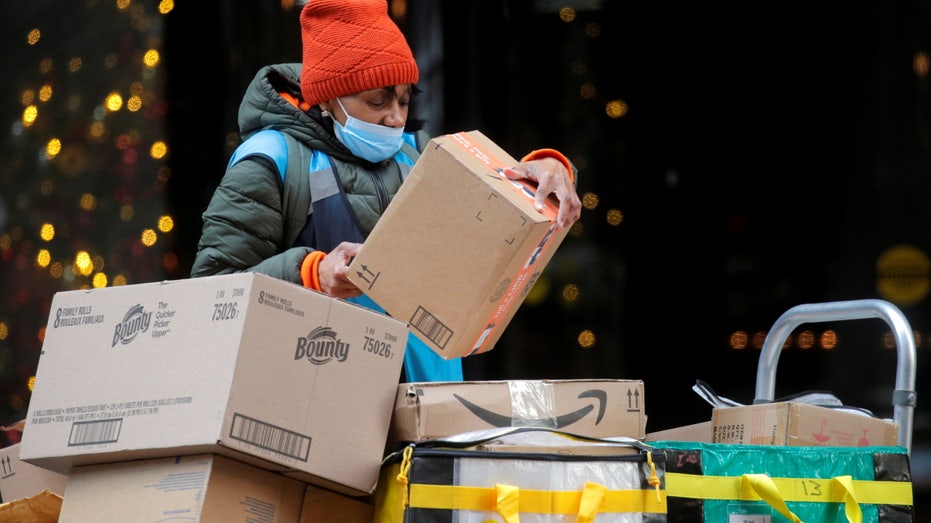

Although online shopping during the holidays can be convenient and time-saving for millions of Americans, there are risks to know about regarding the possible "porch piracy" of your delivered packages.
A new report from CNET, out this morning, says that over $74 billion worth of packages could be left on consumers' doorsteps this holiday season.
In addition, more than 104 million Americans expect to leave their homes unattended for at least a six-hour period — posing an increased risk of porch theft and financial inconvenience for consumers, the same report said.
American consumers could have an average of $287 worth of goods delivered to their individual doorsteps this holiday season, CNET also said.
The organization, a digital media brand, provides information, reviews and analyses of consumer technology products, services and trends.

Workers are shown fulfilling orders at an Amazon fulfillment center in Melville, New York. Today, the risk of package theft from a home's doorstep is a reality. (Johnny Milano/Bloomberg via Getty Images / Getty Images)
The group noted the following spending thresholds on physical items by income bracket.
Additionally, the report revealed that 68% of consumers currently take or plan to take some sort of action to prevent package theft.
Some 32% of consumers will use package tracking technology to trace their package location from order to delivery; 21% will be relying on home security cameras; and 19% will be asking a neighbor or friend to watch the house and/or collect packages.
Still, the risk of theft is a reality.
"Even a little effort can help safeguard you from porch theft."
One in five of Americans have already purchased home security cameras and 10% of Americans opt to spend even more money on top of what they’ve already spent to prevent package theft, CNET said.
Nick Wolny, a Los Angeles-based spokesperson with CNET, told FOX Business that some folks won’t take any action at all.

An Amazon Prime delivery person in a van is shown sorting packages in Queens, New York. There are smart tips to take to reduce the risk of porch piracy today. (Lindsey Nicholson/UCG/Universal Images Group via Getty Images / Getty Images)
Still, "even a little effort can help safeguard you from porch theft," he said.
"Consider taking the time to know your options, so that if you need to have something delivered that is valuable and/or on a short time frame, you know what to do."
Leveraging location tracking status updates was the most-cited preventative strategy, with 32% of respondents incorporating this tactic, said CNET.
"This is good because it means consumers know where their items are, but it’s also not a foolproof strategy," cautioned Wolny.
"It just confirms to you that the shipper has done its job, not that your package will still be there when you get home from work."
Using a security camera or video doorbell to deter thieves had the second-highest number of responses, at 21%, for preventative strategies.
The messaging around these devices is that they lower crime, "but there are conflicting data reports on this claim," adds Wolny.
"Surveillance footage does help you file a successful claim in the event of theft."
"However, surveillance footage does help you file a successful claim in the event of theft, so the splurge on home security tech might be worth it."
Many consumers leave packages unattended for several hours at a time, which increases the chances of theft, Wolny said.
"Know what day and approximate time your packages will arrive so you can shorten this window as much as possible," he said.
"Delivering your package to an Amazon Locker or UPS Store ensures that someone signed for your package and is holding it for you," Wolny told FOX Business.

The best way to keep your holiday packages out of the hands of thieves is to not give them the opportunity to snatch them — see the ideas in this article for how to reduce the risk of theft. (iStock / iStock)
This way, there’s no "limbo" stage in which no one is responsible for your package — a time when porch thieves usually strike, he said.
The Amazon Key service integrates with your smart garage door opener, letting delivery drivers open and close your garage to drop packages off securely, said Wolny.
This service costs $1.99 if you want delivery on a certain day, which is a recent change, he added.
The best way to keep your packages out of the hands of package thieves is to not give them the opportunity to snatch them, said Rebecca Edwards, a spokesperson with Safewise in Spokane, Washington.
"That means not leaving them out unattended on your porch," she said.
Some ways to keep your packages out of sight include the following ideas.
This way delivery people can leave the package in that more secure place — and thieves won't be able to see it.
"An added bonus is that they'll be locked away and difficult to steal," Edwards said.
If your home is within 25 feet of the street, you're more likely to be targeted, as "that's the sweet spot for package thieves," said Edwards.

An Amazon delivery worker stacks boxes for delivery on a cart in Nov. 2021. As one idea to cut down on theft risk, work together with neighbors to come up with a "delivery captain" plan that benefits everyone. (Reuters/Brendan McDermid / Reuters Photos)
So, to reduce the chances of theft, "it can be as simple as letting delivery drivers know where to put a package, whether it's behind a plant or other decor, or on the side of the house instead of the porch," said Edwards.
"If reasonable, most delivery drivers are willing to comply with requests."
"That makes it much easier to plan and make arrangements so that you or someone else can be home to receive the packages," she said.
And, on top of the usual preventive measures such as requiring a signature and signing up for delivery updates, here are some other effective things to do.
Edwards suggests finding out if there’s someone in your neighborhood or building that is home during the day and willing to be a "delivery captain."
"Some neighbors pay a nominal fee per package to compensate the person’s willingness to receive and hold packages."
She said, "They can receive packages while you’re away from home, and you can safely pick them up from them when you return."
She added that she's "seen some neighbors pay a nominal fee per package to compensate the person’s willingness to receive and hold packages or do other neighborly swaps for babysitting, shoveling snow, etc."
This means you don’t have to worry about your package being left unattended, making it vulnerable to porch pirates.

A worker carries a large parcel at the United States Postal Service sorting and processing facility in Nov. 2021 in Boston. If you're sending a package directly to a friend or family member, consider sharing the tracking info with them, one expert re (AP Photo/Charles Krupa, File / AP Newsroom)
Track all of your orders through an app like Shop that lets you get delivery info in one place.
"I've been able to delay or cancel a delivery and have the package held for pickup when I got a notice that my package was on the way to my home when I wasn't able to be there — especially if it's a valuable item," Edwards said.
Also, if you're sending a package directly to a friend or family member, Edwards recommends you share the tracking info with them.
That way, they can respond to drivers or change delivery schedules if they're unable to be home when it arrives.
Filing a police report creates a footprint that can come in handy in later reimbursement efforts.
"I did this with some jewelry sent to my daughter and she was able to change the delivery day and time so she could receive the package," she continued.
"I also required a signature on delivery, which can make it easier to reschedule deliveries."
Still, what happens if your packages do get swiped? What do you do?
Wolny with CNET recommended submitting a claim with the shipper as well as with your home insurance company, as package theft is now classified as home theft.
"Footage from a security camera or video doorbell is very helpful to corroborate the claim," he noted.
Also, he suggested filing a police report. While filing instructions vary by precinct, most local precincts have clear instructions online for how to file.
This creates a footprint that can come in handy in later reimbursement efforts.
